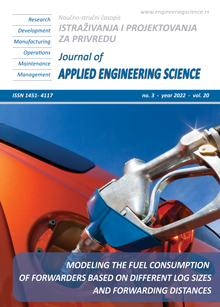THE VALIDITY OF A DECENTRALISED SIMULATION-BASED SYSTEM FOR THE RESOLUTION OF ROAD TRAFFIC CONGESTION
Abstract
Intelligent transport systems are cheaper and easier to implement than other forms of solutions to road traffic congestion. Intelligent Transport Systems (ITS) allow information about road traffic to be collected and transmitted to the Traffic Controllers to respond to traffic congestion appropriately. This research study aims to design and test a simulation-based intelligent transport system for predicting traffic flow patterns. The simulation-based system proposed has a decentralised configuration. Road sections are isolated digitally in a decentralised structure and fed relevant information to predict future traffic states and transmit predicted information to other road sections. Two models of control configuration are created based on the same road network, the first is a decentralised model, and the second is a centralised model (no isolated road sections) to be used as a data source for the decentralised model. The simulated system used decentralised model configurations to predict traffic patterns at road intersections. Due to the lack of actual traffic data, a centralised model serves as the digital twin for the designed decentralised model. The two models were simulated using Anylogic Personal Learning Edition 8.5.2. simulation software, and after testing and result extraction, it was discovered that the decentralised model configuration was not valid for representing the non-uniformity of actual-world traffic patterns. The decentralised model had too few similar inflow and outflow rates to the centralised model in both the complex and straightforward road network cases. However, the decentralised model scored 89% in vehicle population density compared to the centralised model in the simple road network case but could not replicate the good result when the road network becomes complex.
References
Shobayo, O., Olajube, A., Ohere, N., Odusami, M., &Okoyeigbo, O. (2020). Development of Smart Plate Number Recognition System for Fast Cars with Web Application. Applied Computational Intelligence and Soft Computing, doi:10.1155/2020/8535861.
Ede, A., Nwankwo, C., Oyebisi, S., Olofinnade, O., Okeke, A., &Busari, A. (2019, November). Failure trend of transport infrastructure in developing nations: Cases of bridge collapse in Nigeria. In IOP Conference Series: Materials Science and Engineering (Vol. 640, No. 1, p. 012102). IOP Publishing, doi:10.1088/1757-899X/640/1/012102.
Nguyen, Tin T., PanchamyKrishnakumari, Simeon C. Calvert, Hai L. Vu, and Hans Van Lint. "Feature extraction and clustering analysis of highway congestion." Transportation Research Part C: Emerging Technologies 100 (2019): 238-258, doi:10.1016/j.trc.2019.01.017.
Sony, B., Chakravarti, A., & Reddy, M. M. (2019, March). Traffic Congestion Detection using Whale Optimization Algorithm and Multi-Support Vector Machine. In International Conference on Advances in Civil Engineering (ICACE-2019) (Vol. 21, p. 23).
Song, J., Zhao, C., Zhong, S., Nielsen, T. A. S., &Prishchepov, A. V. (2019). Mapping spatio-temporal patterns and detecting the factors of traffic congestion with multi-source data fusion and mining techniques. Computers, Environment and Urban Systems, 77, 101364, doi: 10.1016/j.compenvurbsys.2019.101364.
Rehborn, H., Klenov, S. L., & Palmer, J. (2011). An empirical study of common traffic congestion features based on traffic data measured in the USA, the UK, and Germany. Physica A: Statistical Mechanics and its Applications, 390(23-24), 4466-4485, doi: 10.1016/j.physa.2011.07.004.
Kurniawan, J., Syahra, S. G., & Dewa, C. K. (2018). Traffic congestion detection: learning from CCTV monitoring images using convolutional neural network. Procedia computer science, 144, 291-297, doi: 10.1016/j.procs.2018.10.530.
Walraven, E., Spaan, M. T., & Bakker, B. (2016). Traffic flow optimisation: A reinforcement learning approach. Engineering Applications of Artificial Intelligence, 52, 203-212, doi: 10.1016/j.engappai.2016.01.001 .
Wang, F. Y. (2003, October). Integrated intelligent control and management for urban traffic systems. In Proceedings of the 2003 IEEE International Conference on Intelligent Transportation Systems (Vol. 2, pp. 1313-1317). IEEE, doi: 10.1109/ITSC.2003.1252696.
Jiang, F., Yuen, K. K. R., & Lee, E. W. M. (2020). A long short-term memory-based framework for crash detection on freeways with traffic data of different temporal resolutions. Accident Analysis & Prevention, 141, 105520, doi: 10.1016/j.aap.2020.105520.
Benekohal, R. R. F. (1991). Procedure for validation of microscopic traffic flow simulation models (No. 1320).
Alam, Q. M., Sarker, B., Biswas, B., Zubaer, K. H., Toha, T. R., Nurain, N., & Al Islam, A. A. (2018, May). Towards Simulating Non-lane Based Heterogeneous Road Traffic of Less Developed Countries. In ICT4S (pp. 37-48).
Lehmann, F., Roop, P. S., &Ranjitkar, P. (2020). Extending Particle Hopping Models for road traffic with Timed Automata. Physica A: Statistical Mechanics and its Applications, 553, 124107, doi: 10.1016/j.physa.2019.124107.
Zhou, Z., Lin, S., Li, D., & Xi, Y. (2013). A congestion eliminating control method for large-scale urban traffic networks. IFAC Proceedings Volumes, 46(13), 496-501, doi: 10.3182/20130708-3-CN-2036.00032.
Kwoczek, S., Di Martino, S., &Nejdl, W. (2014). Predicting and visualising traffic congestion in the presence of planned special events. Journal of Visual Languages & Computing, 25(6), 973-980, doi: 10.1016/j.jvlc.2014.10.028.
Kumar, D. M., Arthi, R., Aravindhan, C., Roch, A. A., Priyadarsini, K., & Deny, J. (2021). Traffic Congestion Control Synchronizing and Rerouting Using LoRa. Microprocessors and Microsystems, 104048, doi: 10.1016/j.micpro.2021.104048.
Farda, M., &Balijepalli, C. (2018). Exploring the effectiveness of demand management policy in reducing traffic congestion and environmental pollution: Car-free day and odd-even plate measures for Bandung city in Indonesia. Case Studies on Transport Policy, 6(4), 577-590, doi: 10.1016/j.cstp.2018.07.008.
Ben-Dor, G., Ben-Elia, E., &Benenson, I. (2018). Assessing the impacts of dedicated bus lanes on urban traffic congestion and modal split with an agent-based model. Procedia computer science, 130, 824-829, doi: 10.1016/j.procs.2018.04.071.
Barmpounakis, E., &Geroliminis, N. (2020). On the new era of urban traffic monitoring with massive drone data: The pNEUMA large-scale field experiment. Transportation research part C: emerging technologies, 111, 50-71, doi: 10.1016/j.trc.2019.11.02.

